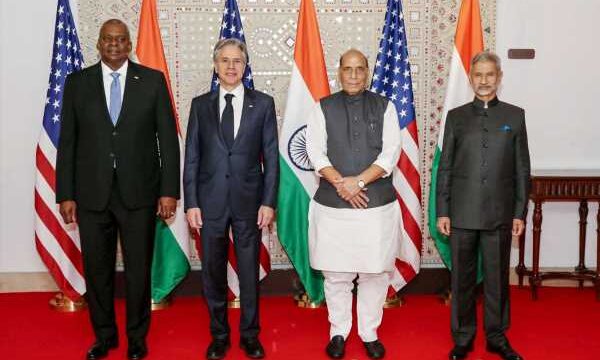The Quad summit to be hosted by India in 2024 is likely to enhance New Delhi’s strategic intent.
The fifth annual Indo-US 2+2 ministerial dialogue has moved the needle significantly forward in aligning India’s foreign policy interests with those of the United States as a counterweight to China’s growing global dominance.
Two broad geopolitical messages were emphasised after meetings in New Delhi between Indian Defence Minister Rajnath Singh and Foreign Minister S Jaishankar and their US counterparts Lloyd J Austin III and Anthony J Blinken.
Both build on Prime Minister Narendra D Modi’s State visit to the US in June.
The first is deepening collaboration between the US military-industrial complex and the Indian defence production establishment.
Second, implicit in the joint statement is a decisive alignment with US foreign policy interests.
The first outcome is implicit in the announcement that India was interested in an initial offer from the US for the joint production of Stryker-armoured vehicles.
Talks on this were taking place under the road map for defence industrial cooperation concluded in June, an all-encompassing agreement that seeks to fast-track collaboration in technology transfer and joint production in a range of critical areas.
These vehicles, manufactured by General Dynamics Land Systems, are likely to be deployed along India’s disputed border with China, where tensions have run high since 2020.
These co-produced vehicles will be armed with anti-tank missiles and some will reportedly be deployed for surveillance.
They are being seen as critical to reducing the Indian military’s traditional dependence on Russian defence equipment and spares, which were increasingly harder to source after the Soviet era and have been near-impossible after the Russian invasion of Ukraine in 2022.
This deal is in addition to agreements for the co-production of General Electric’s GE F-414 jet engine and a $4 billion contract to buy 31 MQ-9B Predator drones manufactured by General Atomics.
These will be deployed by the Indian Navy, which already leases two Predator drones for surveillance in the Indian Ocean Region.
Together with the agreement to ramp up investment in India’s maintenance capabilities for US aircraft and naval vessels, these deals indicate substantial military collaboration, a fact that was clear from an exploratory investors’ meet organised by the US and Indian defence ministries between companies of both countries ahead of the summit.
Undergirding this is the growing convergence of wider geopolitical interests.
Though Hamas was not specifically named, the joint statement carried an unequivocal expression of solidarity with Israel against terrorism and appeal for the release of the hostages.
Though the statement made due mention of humanitarian assistance, there was no reference to India’s settled position supporting the two-state solution as a resolution to the 75-year-old Israel-Palestine conflict.
Significantly, the condemnation of terrorism and its funding and proxies mentioned by name like terror groups designated by the UN Security Council’s 1267 Sanctions Committee — al- Qaeda, ISIS, Lashkar-e-Tayiba, Jaish-e-Mohammed — the statement forbore to mention Pakistan, though the country overtly supports at least three of these groups.
Overall, India’s message to Beijing in its intensifying alliance with the US is well defined in the joint statement.
It used emphatic language to underline the two countries’ commitment to a ‘free, open and inclusive Indo-Pacific’.
The Quad summit to be hosted by India in 2024 is likely to enhance New Delhi’s strategic intent.
How well this serves India’s interests is still to be tested.
Feature Presentation: Aslam Hunani/Rediff.com
Source: Read Full Article
